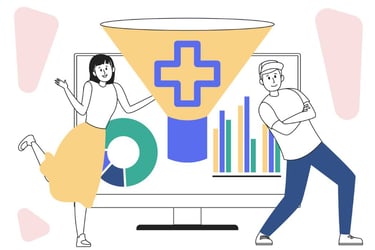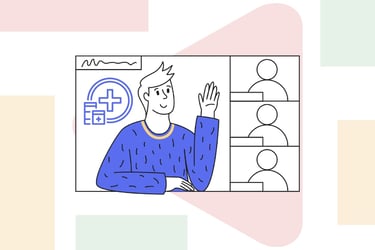Today, I ordered a gold laptop. This is what I learned about marketing from the experience.
I looked at different specs and tried some laptops out for myself. I read reviews and agonised about my impending decision. Then, two very astute women each gave me a piece of helpful advice:
The first told me to 'get what is right for you now.'
The second said, 'How it makes you feel matters - it'll help you do better work.’
These words made me realise that it wasn't processing speed or ports that would help me decide. It was what I envisioned the laptop would allow me to do.
I want to write more and write better. I want to be more versatile and efficient. I want to be the best version of myself The laptop that would enable me to become this version of myself would ultimately be the one I bought.
Technology came second to how each laptop made me feel. The gold one made me feel confident, fabulous, and full of opportunity, while the other made me feel functional, stylish, and comfortable.
So, today, I ordered a gold laptop.
Technology marketing can be too cold
Either you completely relate to that story or think I'm totally barmy. It depends on what kind of technology you use and the **sales and marketing** methods those brands use. Technology marketing has traditionally been quite cold. Full of technical jargon, a focus on the product instead of the people using it, and a missing human element.
Often, technology itself doesn't evoke emotion. What that technology can enable humans to do, however, does. That's why the secret to selling technology is not to talk about technology. Tech industry giant Apple paved the way for this change, shifting the focus of its marketing to user experience, community, and dynamic storytelling.
The gold standard of marketing
People don't want to buy a quarter-inch drill, they want a quarter-inch hole. - Theodore Levitt
This (much-quoted) Harvard Business School professor wasn't wrong, but he didn't quite finish the thought. People don't just want a quarter-inch hole. They want it to hang their new favourite quote print, a much-loved family photo or maybe even one of those maps where you scratch off the places you’ve been. What the drill helps them achieve isn't the quarter-inch hole; it's the improvement of their home and the evocation of memory.
Of course, a tool company isn’t going to develop a marketing strategy solely around memories. There’s more to it than that. But, understanding what people want to do with your product and why they want to do it is the trick to identifying the story that will sell. This is an especially important point when marketing technology.
Not the same old story
We've talked before about features and benefits in marketing. And we've talked about the importance of storytelling. All those points still hold true:
- Benefits sell; features don't
- Benefits build stories, which customers can relate to
- People like stories because we're wired to see our lives as a narrative
However, a story built by a product’s benefits alone is usually too closely tied to the product itself and not what that product empowers a person to do. Like the drill and the quarter-inch hole, it’s too short-sighted. You have to think about what the benefits of your product enable people to do, why they want to do it and how your product enables this.
Selling technology: what are we talking about here?
Let's rewind to 2019 and revisit one of my favourite adverts of all time—that just so happens to be a tech advert.
Apple’s ‘The Surprise’ centres on a young family visiting a recently widowed family member. We see a car journey, squabbling siblings, grief, busy parents, juggling responsibilities, a tiring flight, the holidays, and loss — all very real and very human things.
The ad features Apple’s iPad in almost every shot. Initially portrayed as a way to keep the two young girls occupied, we later learn that they’ve been using the device to create a digital scrapbook honouring their late grandmother. It features family photos, wedding video footage, and a digitally enhanced photo that puts their grandmother back in the picture (one she sadly wasn’t there for). The girls did all of this on the iPad.
There is no mention of internal storage, RAM, processors, or performance. There is no reference to screen size, rear cameras, studio-quality microphones, or thunderbolt ports. Just two little girls doing something to help their grandfather cope with the loss of his wife and bring a teary smile to his face (and the viewers’ faces, too).
Technology is at the center of it all, but it's not talked about.
You can’t rely on emotion alone
Beware though. Consumers aren't just big saps, willing to accept any old emotional tale with technology in the shot and tinkly piano in the background. The story you tell with technology has to add something to a person's life. It has to let them do something they want to do and, crucially, that they couldn't do before. Or, at the very least, it has to be relatable.
Samsung learned this the hard way in 2022 when it released an advert titled ‘Night Owls’ to promote the Galaxy Watch4, Galaxy Buds 2, and Galaxy S22 phones. The ad featured a young woman running alone at two am — something very few women do due to significant safety concerns. While the ad aimed to celebrate individuality, the public deemed it insensitive and unrelatable. It received widespread backlash and was described by Reclaim These Streets founder Jamie Klingler as ‘beyond unrealistic.’
The secret to selling technology is to help people be a bit better than human
Marketing is an imaginative proposal of what we could be if we lived up to our ambitions for ourselves.
We've talked a lot about consumer technology, which is perhaps easier to sell that story around. However, this idea of selling better versions of people is equally applicable to niche, business-to-business (B2B) technology. This kind of technology product is our stock-in-trade at Articulate.
You absolutely shouldn't be talking about the technology when it comes to these kinds of products: even if customers know enough to understand it, it won't make them feel like better versions of themselves. Talking about more efficient backup or secure websites isn't going to get anyone feeling anything about those products either.
More reliable backup that's cheaper and faster and lets you restore your boss’s email in the blink of an eye? Now, that's something that will get your potential customers thinking. It solves a real problem, it'll make you look good to your bit will help you deliver a bit of that magic your colleagues expect IT to provide.
What’s your Difference Engine?
So you've surveyed and researched and talked to customers. You've thought about how your technology product helps them be a better version of themselves and why they want that enhancement. You're almost ready to tell that story.
Now pause.
It’s time to reflect on a few things. Is your story new and authentic? Or if it’s an elevated version of an old story, then what makes it stand out? Too many marketers, copywriters and tech company owners leapfrog over this step and miss entirely. It’s what we at Articulate call your Difference Engine. Put simply, it’s identifying your brand’s ‘special something’. The very thing that makes your customers pick you over a competitor.
'Differentiation is how you establish your business's identity as distinct from others'. It's what makes you original. Maybe even odd. Worthy of attention, expressive, diverse, value-added, authoritative, helpful, customer-focused, people-led, more than the sum of your parts.'
We recently published a book all about this. So if you’re struggling to identify your technology brand’s original story, you can learn more about the Difference Engine here.
Let’s look at selling information technology services, for example
OK, so imagine you're a managed service provider. You want to sell a suite of services that helps users optimize and protect web applications. What do you tell them about? Well, the tech-lover in you might want to talk about features like its global content delivery network (CDN), Single-Sign-On (SSO) capabilities or firewall systems. But remember, none of this actually speaks to the potential buyer's needs.
Instead, start with the problem it solves. It protects users against cyber attacks, ensures your applications can support high traffic volumes, and makes them faster, better, and more resilient. Now, what can these things help humans do that they can’t do without your tech? They can confidently direct customers to their apps without fear of data breaches or dangerous traffic. They can run high-intensity marketing campaigns that drive significant volumes of traffic to their web applications, trusting that they won’t crash. They can be sure customers will access a fast-loading application that will keep them engaged for longer.
The message may be about confidence. Or trust. Relief.
Picture a family-run business operating out of a home, launching an app for the first time. The cynical father who wants to avoid putting his business online. The optimistic and tech-savvy daughter who knows an app is exactly what her parents need. Late nights, nail-biting, kitchen table arguments. A sale is made. And another. And everything goes smoothly. Dad sighs with relief. Mum cheers. The daughter raises her eyebrows knowingly and smiles. Everyone laughs over a cuppa, and there’s no tech acronym in sight.
TL:DR? Refrain from talking about technology and features. Let them be the support in your story. The protagonist is the customer, technology is the best friend that helps them get the job, win the girl (or boy!) and maybe even save the day.
[This content was updated in 2025]





